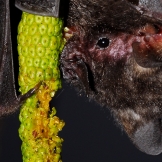Updated: 05/03/2025
Everyone who likes to spend some time in nature, or who has trees at home, knows that several animals love to feed on fruits. Figs, tomatoes, peppers, guavas, mangos, bananas, and many other delicacies are harvested by frugivores that range from tiny bats to huge elephants.
Those animals render the plants a service known as seed dispersal: in other words, they carry their seeds away and so increase the chances of their offspring surviving attacks by natural enemies, establishing, and colonizing new sites. This myriad of interactions forms a tangled web of frugivores and fruits, which is vital to maintain and regenerate forests and other natural ecosystems. Some frugivores seem to be more important than others to keep those webs functioning. In our study “Keystone species in seed dispersal networks are mainly determined by dietary specialization”, focused on bats and birds, the main groups of seed dispersers in the Neotropics, we found out that, even though animals with other kinds of primary diets participate in seed dispersal networks, specialized frugivores are the keystones of those systems and hold them together. This finding may help plan for the conservation and restoration of seed dispersal in degraded areas, and also provide insights on how to accelerate the regeneration of tropical rainforests and savannas.
Marco A.R. Mello and co-authors





